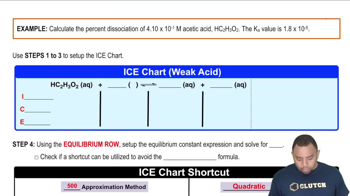Here are the essential concepts you must grasp in order to answer the question correctly.
pH Calculation
pH is a measure of the acidity or basicity of a solution, defined as the negative logarithm of the hydrogen ion concentration. To calculate pH, one must first determine the concentration of hydrogen ions in the solution, which can be derived from the dissociation of acids or the hydrolysis of cations in the case of salts. The formula used is pH = -log[H+].
Recommended video:
Percent Dissociation
Percent dissociation refers to the fraction of a substance that has dissociated into its ions in solution, expressed as a percentage. It is calculated using the formula: (amount dissociated / initial concentration) × 100%. This concept is crucial for understanding the strength of acids and bases, as well as the behavior of salts in solution.
Recommended video:
Percent Dissociation Example
Hydrated Cations and Equilibrium Constants
Hydrated cations are positively charged ions that are surrounded by water molecules, which can affect their reactivity and the pH of the solution. The equilibrium constants, such as K_a for acids or K_b for bases, provide insight into the extent of dissociation or hydrolysis of these cations. For example, the stability of the hydrated iron cation (Fe^3+) can influence the pH and percent dissociation in the solution.
Recommended video:
 Verified step by step guidance
Verified step by step guidance


